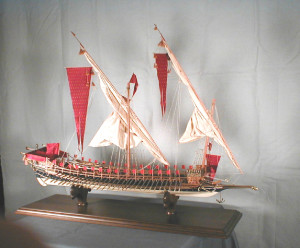.Reale de France, Galley
The Ship
The name Reale indicates that the galley belonged the King of France; also, from 1526 the admiralty vessel of the Captain of the French galleys was also called Reale. The 1:60 scale model is a reproduction of a vessel with a total length of 63 m, 9.70 m wide at the overdeck carrying 59 thwarts and 50 oars, each maneuvered by seven men; there were therefore 413 oarsmen alone. A small part of them were slaves but the majority were criminals condemned to life imprisonment while the “head oarsmen”, i.e. the men at the end of the oar handles were regularly paid volunteers. The rest of the crew consisted, besides the officers at the stern, a galley sergeant and two helpers (who, from the midway, whipped the oarsmen to urge them on) ;and a variable contingent of soldiers and gunners located on the forecastle and along the arbalesters. Armament consisted of five bronze pieces concentrated on the bow under the forecastle on special sliding carriages and eleven swivel guns located on the arbalesters. To train the forecastle guns, the ship had to move. This clearly denotes the limits of use of the galley. Their sole tactics were limited to frontal attack or ramming.
To be used as a sailing vessel, the Reale was equipped with two lateen sails. Before entering battle the sails were always furled and the lateen yard was chained to the mast to prevent them from falling on the oarsmen due to enemy gunfire. As it was very low in the water, the covering was often flooded and, when sailing in a strong wind, thwarts and rowers were often immersed in water.
In the 18th century, the only way for a galley to enter battle with a heavily armed ship was to take advantage of a smooth sea and choose a combat position bow-on to the enemy. However, due to the poor armament, it took a large number of galleys to defeat even a medium-armed three masted ship.
The Model
Uncased
L 34” H 25” W 15”
Built by H.J. Furrer and R.G. Tschabold 1980
On loan from the Nelson Maritime Arts Foundation
